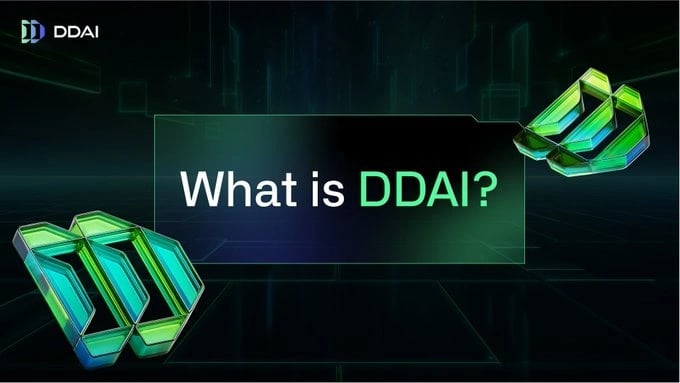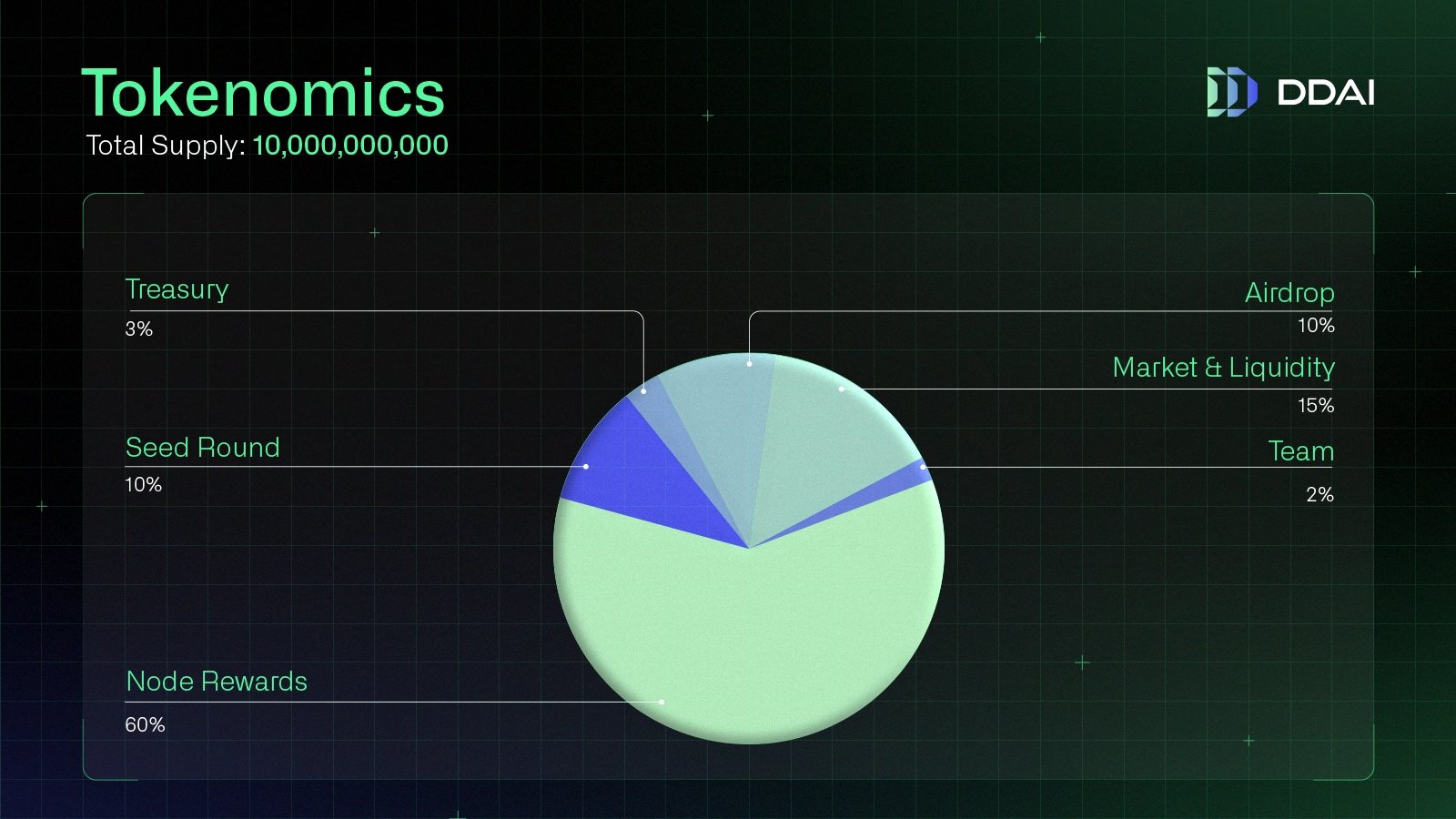Subscribe to wiki
Share wiki
Bookmark
DDAI Network
The Agent Tokenization Platform (ATP):Build autonomous agents with the Agent Development Kit (ADK)
DDAI Network
DDAI Network is an emotionally intelligent artificial intelligence system built on a decentralized infrastructure. It aims to combine emotional intelligence capabilities with blockchain technology to create a privacy-focused AI solution on the Solana ecosystem.
Overview

DDAI is a decentralized AI assistant platform built on the Solana blockchain. It focuses on providing automated, omnichannel communication through AI-driven virtual assistants. Unlike conventional chatbots, DDAI uses natural language processing (NLP) and sentiment analysis to interpret emotional context and respond to complex queries more effectively.
The platform is structured around a Decentralized Physical Infrastructure Network (DePIN), which distributes processing tasks to user-operated nodes. These nodes support the system’s operation while enabling participants to earn revenue through a shared model.
DDAI aims to build a scalable AI infrastructure using Solana’s Proof of History and parallel processing features to ensure efficient, low-latency interactions. It also seeks to simplify AI integration for businesses by offering user-friendly tools and APIs that abstract the technical complexity of blockchain and decentralized systems. [3] [4]
Technology
DePIN Integration
DDAI integrates a Decentralized Physical Infrastructure Network (DePIN) to support its AI assistant platform. This integration allows AI processing and data handling across a distributed network rather than centralized servers. Through DePIN, users can contribute unused internet bandwidth and computing resources to support the system, receiving passive income. The infrastructure enables decentralized AI task execution and data storage, aligning with the platform’s broader goals of privacy, resilience, and shared participation.
DePIN enhances decentralization by removing reliance on centralized entities, reducing risks related to censorship, outages, or unilateral control. It also improves data privacy, as user information is spread across the network, requiring advanced safeguards like encryption and differential privacy to ensure protection. Security benefits include resistance to common centralized threats, such as DDoS attacks, though new challenges like Sybil attacks may emerge. Additionally, DePIN improves accessibility by lowering the technical and financial barriers to deploying AI assistants, supporting a broader range of contributors, and encouraging innovation within the AI ecosystem. [5]
Sybil Attack Mitigation
Several mitigation strategies are incorporated into the DDAI network to reduce the risk of Sybil attacks. One method involves multi-tier analysis of referral patterns, allowing the system to detect clusters of interconnected accounts that may indicate Sybil farms. The network can better identify suspicious behavior linked to coordinated account creation by analyzing activity beyond direct referrals.
Additionally, the platform ties referral rewards to meaningful engagement, such as the actual performance and sustained activity of referred users. This discourages the creation of inactive or fraudulent accounts solely for earning rewards. Further safeguards include requiring verification steps, such as a minimum level of AI assistant usage or resource contribution, before granting referral incentives. These combined measures aim to uphold the integrity of the network while maintaining decentralized participation. [6]
Features
NLP AI Assistant
DDAI features an AI assistant built on advanced Natural Language Processing (NLP), enabling real-time, multilingual interaction across platforms. Unlike rule-based systems, it interprets user intent, tracks conversation history, and adapts responses based on prior exchanges. It incorporates sentiment analysis to detect emotional tone and adjust its behavior accordingly, and leverages entity recognition to extract key details like names or dates from unstructured text. This allows for more accurate responses and task execution, enabling the assistant to continuously improve by learning from user interactions and feedback.
The AI assistant supports a range of practical applications, including automated customer service, IT support, sales onboarding, and internal workflow assistance. These use cases demonstrate its capacity to handle routine and complex tasks with minimal human input. A distinguishing aspect of DDAI’s approach is decentralized infrastructure via DePIN for processing and storage. This model enhances performance, data privacy, and system resilience by moving away from centralized cloud dependencies, making the assistant more adaptable and secure in real-world deployments. [7]
Business Functionality
DDAI offers advanced functionalities designed to support business operations through automation and integration. It can streamline incident management by detecting system anomalies, notifying relevant personnel, providing diagnostic information, and initiating corrective actions. The system also supports proactive problem resolution by analyzing data from the IT infrastructure to identify recurring issues and suggest preventative measures. DDAI enables self-service support for routine technical concerns, guiding users through troubleshooting processes, granting access to documentation, and automating tasks such as software installations.
In addition, DDAI enhances operational efficiency across several domains. It facilitates change management by automating approval workflows, deployment scheduling, and stakeholder communications. It can process logs, identify potential threats, and trigger predefined responses in security operations. DDAI also integrates with IT Service Management tools to automate ticket handling and improve issue tracking. Within DevOps environments, it supports continuous development workflows by automating deployments, testing, and infrastructure tasks while assisting developers with real-time feedback and diagnostics. [8]
Bandwidth Monetization
DDAI incorporates a bandwidth-sharing model that allows users to contribute unused internet capacity through a browser extension. This approach increases efficiency by utilizing idle network resources to support decentralized operations.
Contributors receive passive rewards for their shared bandwidth, which becomes part of the infrastructure that powers the distributed AI Assistant. This system supports the DDAI network's scalability and resilience without relying on centralized providers. [9]
Token
$DDAI is a utility token with a total supply of 10 billion, used to support the decentralized infrastructure of the DDAI AI assistant network. It enables businesses to access services such as custom AI model training through federated learning and intelligent customer support via API integration. Node operators contribute computing and storage resources to power AI workloads and process complex queries, receiving $DDAI as compensation. Some nodes also support blockchain transaction validation, reinforcing network security. Additionally, enterprises can access premium features, including proactive AI support and privacy-preserving model customization.
Beyond infrastructure support, $DDAI is central to governance and platform participation. Token holders engage in DAO-based decision-making, influencing node rewards, approving strategic partnerships, and guiding protocol upgrades. Staking mechanisms further ensure reliability and engagement—node operators must stake tokens to participate, with penalties for misconduct. In contrast, users and businesses can stake $DDAI to unlock benefits such as reduced fees and early feature access. These combined functions position $DDAI as a core asset for operating, securing, and evolving the decentralized AI ecosystem. [10]
Tokenomics

$DDAI has the following allocation: [11]
- Node Rewards: 60%
- Market & Liquidity: 15%
- Seed Round: 10%
- Airdrop: 10%
- Treasury: 3%
- Team: 2%
Partnerships
AtuaAI
Collably
See something wrong?
The Agent Tokenization Platform (ATP):Build autonomous agents with the Agent Development Kit (ADK)
